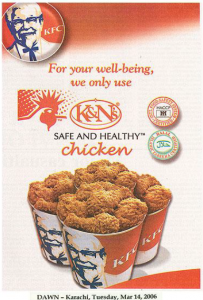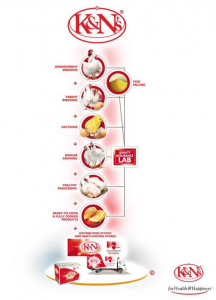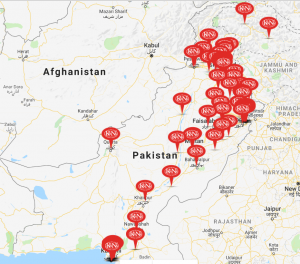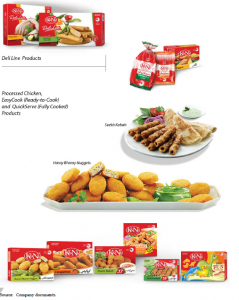38 K&N’s: A Vertically Integrated Business Approach
Khalil Sattar while reading newspaper in veranda in his house in northwestern, Pakistan on Sep. 2011 started thinking of his dream of a happy and healthy nation.
Khalil Sattar established poultry business “K&N’s” in Pakistan in 1964 with his wife Naushaba Khalil (hence the name K&N’s). In September 2011, K&N’s was now run with his son Adil K. Sattar(1). Khalil started K&N’s with the single mission “to provide better nutrition for the health and happiness of the nation”.
K&N’s was one of the largest broiler-chick producers and the market leader for the processed chicken products in Pakistan, in 2011, with the projected sales of US$ 250 million. It was unbelievable for international visitors to the company’s facilities to see world-class poultry producers in a country with political and economic challenges. Khalil and Adil not only successfully handled those challenges but also ran an industry that was regularly challenged by diseases, poor quality standards, an uncertain regulatory and tax environment, and wet market.
K&N’s earned confidence among consumers through quality and food safety and it was, therefore, the top choice of consumers and international food-food service operators such as KFC (Fig.1) which promoted K&N’s in its advertisements. Sattar’s always wanted to do more in this industry by increasing the percentage of broiler chicks they produced for processing operations. They also felt that their business could grow more by increasing the volume of chicken and by offering comparably low cost to compete for the wet market.
Rapid urbanization, a growing middle class, and a rising number of women working outside the home raised demand for processed products which assisted K&N’s to achieve its goal and to keep focused on domestic market demand. K&N’s without degrading wet-market stayed focussed on its goal to provide “Safe and Healthy chicken” which positioned it as a top-selling chicken brand in Pakistan.
K&N’s was interested to expand its business strategies at the international level but OIE (Organization of Animal Health) banned the export of poultry from Pakistan in 2006 due to the bird flu epidemic. The ban was lifted in 2008 but each country visited Pakistan to further verify the safety and health of poultry before accepting imports.
UAE approved K&N’s for import of poultry and poultry products in 2011 after the ban was lifted. After that, other neighboring countries like Afghanistan and Saudi Arabia, Oman also approved import from K&N’s, Pakistan. Sattars’ were concerned with the imports to these rich states, as these markets looked temporary to them because of their wealthy government which could decide to have their own poultry industries any time as wealth was not an issue for them to raise any industry locally.
Sattars’ were looking for avenues to enter into the western market with strong footing as they were fascinated with the large Halal food market which was growing rapidly in the west such as the U.S., the U.K, and France where there was real potential to grow and also people enjoyed higher incomes than Asia. But they were not sure if the Pakistani company could do business in western countries or would K&N’s meet western standards of the market?
The company efficiently worked on gaps it had in its business to be more cost efficient so by 2011 it was the only fully vertically integrated poultry industry (Fig. 2) in country which had its own broiler-chick producers in the country, the largest broiler grower, the largest chicken processor, and the market and brand leader for processed chicken and value-added chicken products, with their own feed mill. In order to gain more confidence of customers, K&N’s realized a video on their website in which birds were being slaughtered in a truly Islamic way. The company was working with the basic objective of providing safe and healthy proteins to meet the nutritional needs of citizens. Khalil believed that it was the only source of animal protein that can feed the nation in a cost-effective manner (2).
Khalil, who was a chairman and CEO of K&N’s, was looking matters related to his business on a daily basis and later in 1997 Adil, joined as executive director after completing his undergraduate degree in agricultural economics and business management with classes in poultry science at Cornell University. Strategy development and its effective implementation were taken care of by Sattars themselves. They hired a large and experienced senior management team to support them. They had 4,134 staff members in 64 facilities in 2011 all around Pakistan. In 2011, the business employed 4,134 people in 64 facilities located around Pakistan (Fig.3 for a map of K&N’s locations) (3)
K&N’s, in 2011, categorized its vast business into two areas for internal management purposes: K&N’s Poultry, which had parent stock production unit, day-old chicks, feed and broilers, and K&N’s Foods to control processed chicken and ready-to-cook and fully cooked chicken products.
- K&N’s Poultry
K&N’s Poultry consisted of parent-stock production, day-old chick production, and broiler growing, as well as a layer breeding business which produced an average of 1.8 million chicks per week, including 1.55 million broiler chicks, 210,000layer chicks, and 40,000 broiler parent stock in 2011(1).
The company used around a quarter million of the chicks for its own farms and another 130,000 were placed with contract growers to be raised for K&N’s Foods which were advised by K&N’s on farming and feeding, with regularly monitoring the health of contract-grower flocks. K&N’s also supplied its broiler-chicks to Pakistan’s independent broiler growers for sale to the wet market or to smaller poultry processors.
The other challenges, to the industry, were; disease control, access to quality feed, and a generally low priority attached to product quality and food safety. K&N’s tackled these challenges strategically by raising the broiler houses away from parent flocks and from other producers in order to reduce the threat of disease. K&N’s developed its own quality assurance laboratory and had its own feed mill, to provide safety and healthy chicken all over Pakistan. Sattars also established the K&N’s Poultry Diagnostic & Research Institute in 1989 with the support of the U.S. Agency for International Development (USAID) which had internationally trained experts capable of diagnosing problems of bird disease and productivity and was also conducted tests on feed and feed raw materials. This integration resulted in improved quality and quantity of business (4).
2. K&N’s Foods
K&N’s Foods comprised of produced products including whole chickens, bone-in cuts, premium boneless meat, and value-added chicken products such as kebabs, nuggets, sausages, and deli-style cold cuts, and smoked meat. All its products were frozen. The company operations were certified under HACCP and ISO 9001: 2015, USDA, HALAL, FSSC (5)
There was much demand for processed products by consumers for which broilers were brought in special trucks to the processing unit where they were slaughtered before processing into various value-added chicken products. Ready-to-cook products, easy cook and quick-serve products were specialty items of the company which brought more convenience to the consumers. These included nuggets, burger patties, croquettes, shami kebabs, chicken sausages, cold cuts, and smoked meats, Chicken Tikka Chunks, which were spicy bite-sized pieces of chicken good for topping pizzas, salads, or sandwiches (Fig. 4. for product images).
Innovations and continuous investment in marketing gave K&N’s a reputable position in processed chicken. It earned consumer’s confidence by providing safe and healthy chicken products in the markets over many years. It also raised consumers awareness level who previously preferred wet market shifted towards safe & healthy chicken products. Halal slaughtering in K&N’s was in question by consumers which were resolved by providing video that showed all slaughtering process at the company’s website www.KandNs.com, to promote public confidence and satisfaction. It also got two Halal certifications which were mentioned on the website as proof for consumers.
Many retail outlets were opened in 2003 to facilitate the consumers and by 2011 there were 68 stores located at different locations in the country. Due to the absence of an organized retail market in the country, the company could not find experienced retail workers to hire in the initial opening of the stores, but this was overcome by providing a clearly defined manual of all procedural handling and operating instructions. All the stores were connected with the main location at Lahore through video cameras to monitor and ensure that retail manual was being followed by the staff. In case of any negligence, the stores were visited by Adil to investigate the reason.
The company also introduced “The K&N’s Way Club” to accelerate its penetration and encouraging its existing customers to turn their most loyal customer. It also got good recognition through advertising on TV, radio, print, outdoor media. Sattars’ knew that the middle class was their real market, so they talked to them directly to increase that market which would increase their business.
K&N’s earned its name in Pakistan due to its quality products in the market. It won the National brand of the year award each year since 2006(4). KFC, McDonald, and Nando’s also approved K&N’s quality chicken and K&N’s was 100% sole supplier of chicken to these international restaurant franchises and many of the domestic restaurants in Pakistan in 2011(1).
K&N’s had price control upon its products as compared to its competitors such as wet market where the prices fluctuated through the year. K&N’s was the market price leader for chicken.
Khalil and Adil were successful by having a complete vertically integrated strategy for their business. The company grew substantially between 2001-2010 where it produced broilers chicks from 24.5 million to 80 million, processing meat rose from 3,500 tons to 28,000 tons. Sattars started exploring to extend their business to adjacent countries and also to invest in the global market for Halal products to fill the gaps at the international level.
Domestic growth of the company was improving on one hand but was also having challenges due to the wet market. The wet market had the advantage of the slaughtering of chickens where the customers were sure that the birds were halal when slaughtered in their presence. But with the investment from foreign retailers and improvement in the upper and upper middle class shifted the wet market trend quickly.
Other challenges included were the competition with the imported chicken in 2011. Malaysia and Pakistan had trade agreement for import of finished poultry products which caused local producers to import from there for the retail market. Another challenge was safety and quality provision of the food services which costed more to costumers as compared to other options where cost was low, and quality was not much problem.
Khalil had invested heavily for the nation to provide nutritious and safe protein sources which were unfortunately still protein deficient. Would it be a successful approach to stay focused on the Pakistani market to reach his goal? How could he get more customers for processed products? How could the purchase be improved, were few of the future concerns of the company?
Neighboring countries were importing poultry meat and products from K&N’s after the ban from poultry export from Pakistan was lifted but Khalil was more interested to grow his business in global market, to exploit more opportunities and build relationship globularly but the questions, like could it be affordable for him to have the same model in another country? Would it be good or bad for the people of Pakistan? were difficult for him to answer. But Khalil found a wider opportunity to tap the global market for Halal foods.
Provision of Halal food was always a big problem for Muslims living in Europe and U.S and increasing number of Muslims in these areas could help Sattars gain their goals. There were few other companies already offering Halal products such as Nestlé was the largest producer of Halal products in the world, also Tesco and Carrefour had also Halal offerings (1). It seemed a big market to Khalil as halal slaughtering was not available everywhere in the world. Also, Halal certification was another area where he could work to get more costumers.
Muslims consumers needed guaranteed halal products when buying groceries in non-Muslims countries which were not easy to have appropriately slaughtered according to Halal requirements in those countries, so Khalil found this market had great potential to grow. K&N’s got credibility in Pakistan due to its high standard of services and reliable source of safe and healthy chicken, got approval in U.S and Europe to serve its processed products.
Retailers from other countries like Spain also visited K&N’s facilities in Pakistan to investigate its supply opportunities who were surprised to see the standards, logistics, food processing and distribution business in a company in Pakistan which was comparable to any western company.
Khalil and Adil took advantage of the global Halal market but they wondered whether Halal products be welcomed? would it be practical for a company in Pakistan to do business in Europe and U.S? It was due to their devotedness and continuous hard work that K&N’s got established units at UAE and U.S(6).
Khalil, while sitting in veranda in his home in the northern Pakistan, with Adil told him that his request on behalf of PPA (Pakistan Poultry Association) had been approved by Government where he requested the government to support poultry industry by providing incentives to exporters and by changing tax regimes to promote Pakistan as a meat exporter to other Muslim countries. He was further assured that the Government would support this industry and would work on his proposal. This sounded him as a big achievement to get to his goal to see Pakistan prosperous and healthy one day.
References:
- 1) https://kandns.com/global/thebrand/index.html#humblebeginning
- 2) Bell, D., Mcloughlin, D., and Shelman, M. (2012). K&N’s: Health and Happiness for Pakistan.9-512-002. Harvard Business School Publishing
- 3) Retrieved from: https://kandns.pk/stores/index.html
- 4) Rederived from: http://www.kandns.com/
- 5) “Brands of the year award 2010” Pakistan Brand Foundation, http://www.brand award.com. retrieved November 2011.
- 6) Retrieved from https://kandns.pk/index.html




